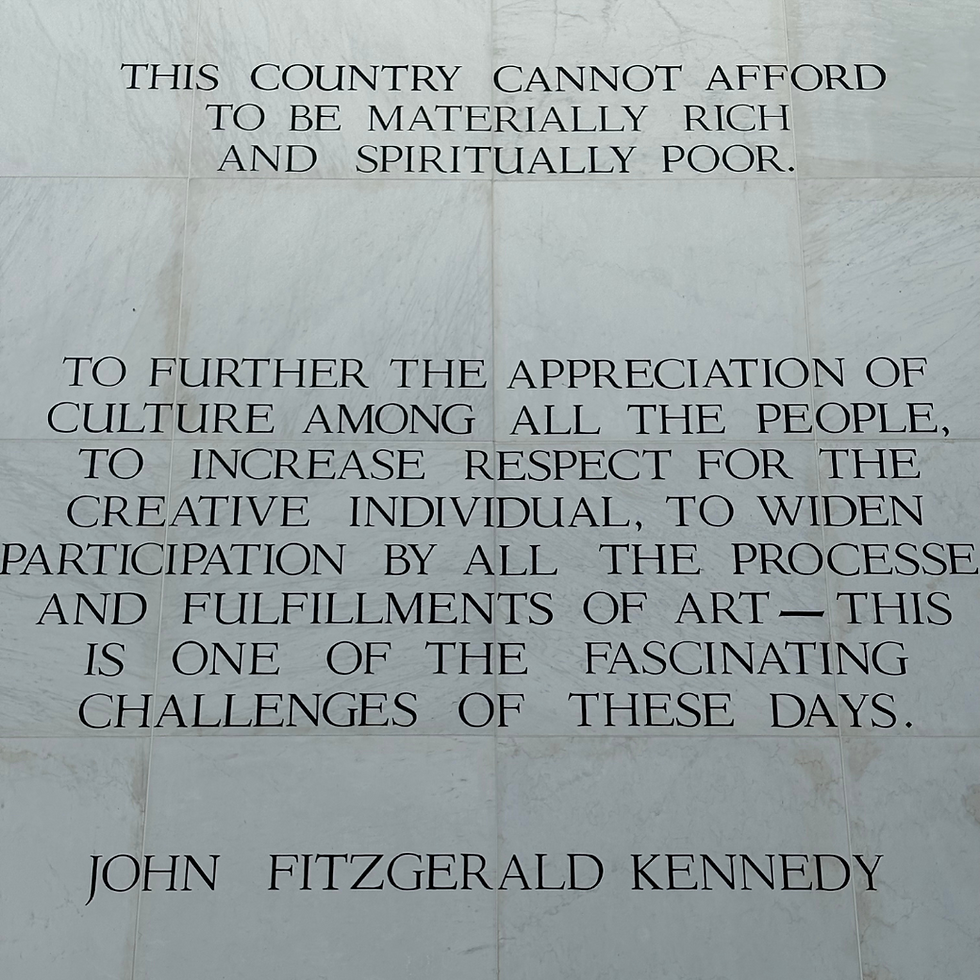From Barricades to Boardrooms: Leadership Lesson #24601
- Nyla Beth Gawel

- Jun 26
- 4 min read
Last night, my husband and I had the privilege of experiencing Les Misérables at the John F. Kennedy Center for the Performing Arts. I'll admit, I cried incessantly. There's something profoundly moving about witnessing this masterpiece in the very venue where it first premiered in the United States, even before its Broadway debut.
Living near the Kennedy Center is a gift I don't take for granted, but this particular evening reminded me why JFK's vision for this cultural institution remains so relevant to leadership today. Walking past his inscribed words on the building's marble walls, "This country cannot afford to be materially rich and spiritually poor," I was struck by how perfectly they set the stage for the leadership lessons that would unfold on stage.

Three Models of Leadership
As the story unfolded, I couldn't help but see parallels between Victor Hugo's characters and the leadership archetypes we encounter in business every day:
Jean Valjean: The Transformational Leader
Valjean embodies the established company that learns to evolve. Like the best legacy organizations, he carries the weight of his past while choosing transformation over stagnation. His leadership is marked by:
Redemptive vision: He sees potential where others see only problems
Moral courage: He makes difficult decisions based on values, not convenience
Mentorship: He invests in others' growth (Cosette, Marius) without expecting personal gain
Authentic change: His transformation is genuine, not performative
Think of companies like Microsoft under Satya Nadella – organizations that acknowledged their past shortcomings and chose radical transformation over defensive positioning.
To be able to evolve with time, environmental circumstances, and self-reflection are indications of a stronger path to resilient and sustainable growth. Ultimately it’s a journey that requires humility, gratitude, reflection, and adaptability… all while making tough choices that emphasize alignment to values.
Javert: The Rigid Authority
Javert represents the company that cannot adapt. His unwavering commitment to "the rules" becomes his downfall because he cannot fathom that people – and organizations – can fundamentally change. His leadership style reflects:
Binary thinking: Everything is either right or wrong, with no room for nuance
Past-focused: Defines people by their worst moments rather than their potential
Inflexible systems: Values process over outcomes, rules over relationships
Fear of change: Views transformation as weakness rather than strength
We've all seen organizations like this: companies that cling to outdated practices because "that's how we've always done it," ultimately becoming irrelevant in a changing marketplace.
Javert is ultimately forgiven for doing his role, despite the hardship he creates. His unwillingness to see context or proportionality, combined with a lack of empathy, creates a leader who is feared, but not followed. Similarly, companies that over index on compliance to the detriment of innovation or efficiency over potential are likely to see their own eventual plummet.
Marius: The Passionate Startup
Young Marius embodies startup energy – idealistic, passionate, sometimes naive, but willing to fight for what he believes in. His leadership characteristics include:
Visionary passion: Sees a better future and fights for it
Risk tolerance: Willing to sacrifice comfort for principle
Collaborative spirit: Builds movements, not just businesses
Learning agility: Grows through experience and relationships
But here's what struck me most about Marius: his ideas are beautiful, revolutionary, and completely untested. He rallies people to the barricades for a cause that, while morally compelling, lacks the practical foundation to succeed. Sound familiar?
Like some startups, Marius operates from a place of privilege – he has the luxury of fighting for theoretical ideals because he hasn't had to prove they work in the real world.
His revolution is passionate but not profitable, inspiring but not sustainable. The barricades represent that classic startup trap: building something people might want rather than something people will actually buy.
Marius's journey mirrors the startup founder who raises capital based on vision alone, then discovers that market reality is far more complex than their pitch deck suggested. The ideas aren't bad – they're just not yet attainable or winnable without the hard work of proving product-market fit.
The Kennedy Center Connection
There's something particularly fitting about experiencing these leadership lessons at the Kennedy Center. JFK's own words, carved into the building's foundation, speak to the balance every leader must strike: "I look forward to an America which will reward achievement in the arts as we reward achievement in business or statecraft."
This balance between material success and spiritual richness, between profit and purpose, is exactly what separates transformational leaders like Valjean from rigid authorities like Javert.
Leadership Lessons for Today
As I wiped away tears during the finale, I reflected on what these characters teach us about modern leadership:
Transformation is always possible: but it requires genuine commitment, not just lip service
Rigid thinking kills organizations: the ability to evolve is what separates thriving companies from dying ones
Passion must be coupled with wisdom: startup energy needs experienced guidance to create sustainable growth
Values-based leadership resonates: people follow leaders who stand for something greater than themselves
The power of live theater, especially in a venue as historically significant as the Kennedy Center, reminds us that the stories that move us most deeply are often about ordinary people making extraordinary choices under pressure. Isn't that exactly what leadership is?
As we face our own barricades in business and life, the question isn't whether we'll encounter challenges, but how we'll choose to meet them. Will we transform like Valjean, remain rigid like Javert, or bring passionate energy like Marius?
The answer might just determine whether our organizations, and our legacies, truly embody JFK's vision of a nation that values both material achievement and spiritual richness.

What leadership lessons have you drawn from unexpected places? I'd love to hear about the moments - whether from theater, literature, or life - that changed how you think about leadership.



Comments